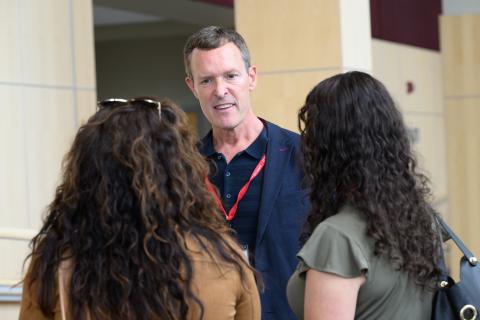Latest News

As a competitive triathlete, Ben Maddox has a personal perspective of growth: he’s learned to identify the sweet spot of discomfort necessary to achieve his next incremental change in time or distance. But as the Chief Information Officer for Cornell’s Ithaca campus and Cornell Tech, Maddox understands big changes can only succeed when they incorporate the university community’s many and different views.
“We all thrive when we engage, listen, and learn from one another,” he said. “When I think about a transformation like reimagining our student, faculty, and staff interactions with administrative services, the compelling story of the outcomes is so critical. We recognize the diverse perspectives of our stakeholders, including student, faculty, and staff community members, IT professionals, system users, and decision-makers. To address these unique viewpoints, we solicit information through conversations, then reiterate what we’ve learned through stories about the benefits of a desired change. The stories that evolve from these conversations resonate with other community members who identify with those unique stakeholder groups.”
For a campus-wide transformation initiative like CEMI, Maddox emphasized the value of four initial types of small group conversations focused on the stories and analogies that Cornell’s many community members tell to describe what they need from administrative services and the challenges they face.
Audience 1: Cornell community members who interact with the services
Maddox often thinks about challenges by posing questions such as, “What are people doing throughout their workday and what data do they need, add, or edit? How easily are they able to accomplish those activities? Is help available how and when they need it?”
When gathering responses to questions like these, Maddox believes intentional listening followed by repeating and clarifying the stories and analogies that Cornell students, faculty, staff, alumni, and family members tell about administrative services is essential to understanding their needs and challenges, in their own words.
Audience 2: IT Professionals
Conversely, IT professionals who support broadly used university systems often lean into technical descriptions when talking to other engineers, technicians, and vendor representatives. They quickly identify specific hardware and software challenges or opportunities and focus on how system changes or implementing new systems will enhance infrastructure, data management, and application performance.
Maddox said, “When talking with IT professionals about future technologies, it is important to discuss success stories from similar projects as we discern potential benefits and foster a sense of shared purpose.”
Audience 3: Power Users
Another critical perspective comes from the people who interact with university systems extensively, at a more intense pace and across multiple tiers of those systems -- individuals sometimes considered to be “power users.” Their enhanced permissions and expertise in navigating and leveraging those systems makes them well-positioned to highlight bottlenecks in their daily work and in how various systems interact.
“Ask them for real-life scenarios that illustrate how changes could make their tasks easier or more efficient and follow up by inquiring where they would direct the time that would free up. The projects they want to work on next can provide valuable insights into the change currently under consideration,” Maddox said.
Audience 4: Decision-Makers
For Cornell leaders, the administrative systems help them make decisions based on data and analytics. Learning what these decision-makers need requires a fourth style of conversation and, like everyone else, these individuals want to know what’s in it for them. Maddox does not hesitate to address this concern immediately. He said, “Start conversations with decision-makers by asking what they want or what their current system does not provide or do that could make their goals easier to accomplish.”
The narratives of decision-makers round out the picture by underscoring the strategic advantages of making changes to systems and providing insights into how these changes will support informed decision-making and drive organizational success.
“By tailoring our conversations to the needs and interests of each group, we ensure that everyone feels informed, valued, and engaged in the change process,” said Maddox.


Comments?
To share feedback about this page or request support, log in with your NetID